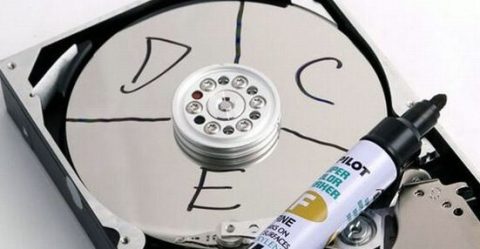Many people “partition” their hard disk to divide mass storage into separate sections, while others do it to improve the efficiency of their computer’s hard disk.
Dividing the hard disk into partitions is even more useful for people who run more than one operating system.
But sometimes the process fails, preventing you from accessing your files and documents. In this case, you need to recover the data from the “partitioned” hard disk.
Is this possible?
In this article, we will discuss the meaning of partition, what it is used for, the possible problems that can occur during the partitioning process, and show you the two methods for recovering data from a “partitioned/repartitioned” hard disk.

What is “partitioning” a hard disk?
“Partitioning” is just another word for dividing. When you “partition” a hard disk, you are dividing the drive into specific segmented parts. Most hard disks, including external drives, come with only one partition.
To understand it better, think of a single partition as a big bucket where all the files are kept on the disk.
Most PC installations include the operating system (OS) itself, programs and personal data on a single partition. But there is a way to divide this large bucket into several smaller buckets.
For example, some devices come with a second, smaller partition, which is used for recovery purposes, should a part of the hard disk or device fail.
However, there are many other reasons why you might want to divide your hard disk into partitions.
What is disk partitioning for?
The reasons for dividing hard disks into partitions include not only improving the performance, but also helping with recovery if the hard disk is damaged. What’s more:
Backup/protection against unplanned system failure
When you keep your personal data – such as music, photos and documents on their own partition – backing up is much easier.
After all, instead of copying all the system files and programs during a backup, you only need to keep a copy of what really matters.
Your data is generally protected when it’s on its own partition – and that can be very useful in the event of a hard disk or system failure.
In addition, even if you need to reinstall your operating system, your “partitioned” personal data will be there when the installation is complete.
To improve the functioning of various operating systems
By dividing a hard disk into partitions, you can also install another operating system on your device.
So you can, for example, create a new drive partition for Linux, without having to touch your installed Windows system.
Alternatively, you can also install an older version of your operating system on a separate partition for backward compatibility purposes.
What’s more, the partition allows the operating systems to work perfectly together on the same computer.
Good organization of vital data
Dividing your hard disk into partitions allows you to add more dividers between data types. With this, you can – for example – create a partition for games and applications and another for documents, music and files.
So if you find that the organization methods available on a single partition aren’t enough, adding new ones can help keep your data organized.
Possible problems that can occur when “partitioning” a hard disk
Even though it is a good solution in some cases, dividing your hard disk into partitions can also bring some risks.
These include
Computer failure
If, during the division into partitions, there are too many interruptions/drops in the flow of electricity, the hard disk can jam and overwrite the data.
If this happens, your files will be corrupted and even your operating system may crash.
Hard disk overheating
Depending on the physical state of your computer, it may end up overheating during the “partitioning” process – causing the operating system to fail (which always happens when the system operates at temperatures close to 60ºC).
Firmware error
A firmware error is when the system is unable to identify the hard disk, caused by the hard disk’s inability to spin at its normal pace, causing it to jam at some point.
It should be noted that a firmware error not only interrupts the disk partitioning process, but also compromises the security of your PC and your device’s database.
And when I need to recover data from a “partitioned” hard disk?
Some of the signs that indicate you need to recover data from your hard disk divided into partitions are:
- Operating system not found;
- FAT invalid or corrupted;
- File or program not found;
- Command.com invalid;
- Primary/secondary hard disk failure;
- Disk error.
How do I recover files from a partitioned hard disk?
There are 2 alternatives for those who need to recover data from a hard disk divided into partitions:
- Using software: a method that requires technical knowledge, familiarity with the process and – even then – risks not working, as well as aggravating the data loss situation.
- Leave the recovery in the hands of a specialized company: the only safe way to recover the data, without running the risk of losing the data or compromising the functioning of the hard drive.
If you want to take a chance and recover your data using software, follow the steps below (please note that this is not the ideal solution):
Select the partition to check for lost data.
First, choose software to recover data from your “partitioned” hard disk. Here are some alternatives, with their respective pros and cons.
Next, install the tool and run it. Then open and select the partition from which you want to recover the lost data.
Find and view the lost partition data in the scan result.
Once this is done, the tool will start a scan to identify the recoverable files and documents on your partition. Wait for it to finish.
Select and recover the data from the lost partition
After the scan, the tool will display the files that can be recovered from your “partitioned” hard disk.
Select the ones you would like to recover and wait for the recovery process to complete.
Conclusion
Partitioning a hard drive can be a good alternative to facilitate backups, improve the functioning of a PC working with different operating systems and even ensure better data organization.
However, some problems threaten the efficiency of the hard disk partitioning process – such as computer crashes, the disk overheating and firmware errors.
When any of these problems occur, you end up needing to recover data from your hard disk divided into partitions – such as operating system not found, invalid or corrupted FAT.
As well as problems such as file or program not found, invalid Command.com, primary/secondary hard disk failure, disk error, among others.
When you encounter any of these problems and need to recover the data on your hard drive, there are two ways to go: use software (an alternative that runs the risk of not working, as well as requiring technical knowledge) or leave the recovery in the hands of a company that specializes in it.
A company like Bot, which has been recovering data from “partitioned” hard disks for more than a decade, uses the latest and safest technology to ensure that the integrity of your device is preserved.
As well as analyzing and giving you a quote within 48 hours, we don’t charge for collecting your device from any address in Portugal.
Best of all, we can answer any questions you may have on our social networks – any time of the day or night.
Become one of our more than 100,000 successfully resolved cases: start your data recovery with us now!


